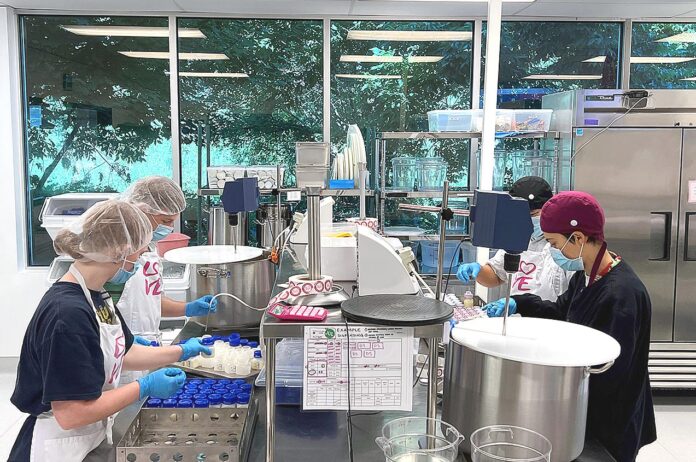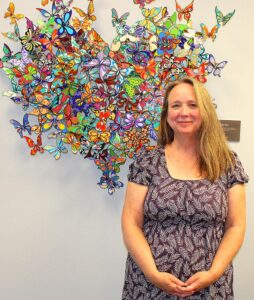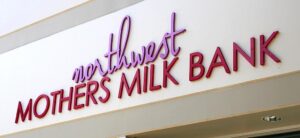
August is National Breastfeeding Month, and on an industrial street in Tigard, an organization is going about the business of providing lifesaving milk to society’s most fragile members: premature babies, newborns and infants with medical needs.
The Northwest Mothers Milk Bank, an accredited facility of the Milk Banking Association of North America and the only facility in the Northwest, serves Oregon, Washington, Idaho and Alaska.
According to Development Coordinator Kathryn Foubister, the Tigard location currently has about 800 donors, with 80 percent of the donated milk going to hospital neonatal intensive care units and the remainder to community needs.
But the process to convert breast milk into the pasteurized final product is as technical and regulated as any other medicine or food product in the U.S. And the volume of milk that passes through the facility is pretty remarkable: It has dispensed 2.9 million ounces since opening its doors nine years ago, which includes 395,000 ounces so far this year.
The process to become a donor is extensive. Prospective donors fill out an initial form and do a phone interview, which then leads to filling out an extensive questionnaire about their lifestyle and health. Their medical provider must clear them to provide milk, and they undergo blood testing to make sure they don’t have viruses that could be passed on to babies. If the prospective donor passes all the tests and requirements, they are approved to be a donor. Their first donation must be at least 100 ounces, but there is no minimum requirement after that.
Donors, whose own babies range in age from a couple of months old to over 1 year old, drop off their frozen milk in bottles or milk collection bags at the milk bank, where it immediately is logged in with the donor’s ID number and kept frozen. When the milk is ready to be processed, it is thawed, and donations from two to five donors are mixed together into each batch based on calorie count and other factors. Each batch of milk is poured into glass or plastic bottles ranging from 1 ½ to four ounces and goes through the Holder pasteurization process, which involves a lower temperature than the regular pasteurization process to preserve the enzymes. Many of the hospital partners prefer glass so the bottles can be recycled.

“Then it is immediately cooled down and frozen,” Foubister said. “Random samples are sent to an independent lab to be checked, and throughout the process, the temperature is verified. Everything is digitized with bar codes, so we know which donors provided which batch, and we maintain the records for 20 years.”
The final product is stored in a huge walk-in freezer for five to 10 days before being shipped out overnight in dry ice. “We will ship anywhere,” Foubister said. “We serve 80 hospitals, which have standing orders. And this is a way for moms to connect with their babies in the NICU. Some are producing milk, but their babies are in the NICU and can’t use it all. One mom with a baby in the NICU pumped thousands of ounces over a year.
“And some moms who lose their babies will keep donating milk as a way to honor their babies.”
The milk bank charges a processing fee for each ounce of milk dispensed, which allows the organization to ensure the milk it distributes is safe, pasteurized and free of viruses and bacteria. To provide donor milk at reduced or no cost, the organization continually works to raise funds through private donations, fundraising events and foundation support.
In 2014 the milk bank established a community care program, called Evie’s Fund, to cover the costs of donor human milk for families who can’t afford it. The milk bank’s priority is serving hospitalized infants, but once those needs are met, the milk bank serves babies who have been discharged but still have medical needs.
Infants receive milk through Evie’s Fund for a variety of diagnoses every year that include being premature, failure to thrive, maternal cancer, post-surgical complications, severe formula intolerance and complicated genetic disorders. Requests are up 30 percent this year.
Another unique program the milk bank offers is to provide a way for nursing moms incarcerated at Coffee Creek Correctional Facility in Wilsonville to provide their babies with their own milk.
“We provide lactation help and the collection bags to the moms, and once a week, a courier picks it up,” Foubister said. “We keep it here in a freezer separate from the donated milk, and the babies’ caregivers either pick it up or we ship it out.”
The milk bank opened in 2013 after five or six years of planning and fundraising, and it moved into its nearly 10,000-square-foot facility with its own lab, coolers, freezers, offices, community room and “June’s Room” for nursing and pumping moms on 74th Avenue in February 2020.
The Centers for Disease Control and the Federal Drug Administration provide input to the Human Milk Banking Association for regulation “because we’re a mix of labs and food manufacturers,” Foubister said. The agencies do not regulate the milk banks directly.
The Northwest Mothers Milk Bank employs 22 people, or the equivalent of 17 full-time employees, according to Executive Director Lesley Mondeaux.
“Providing breast milk to infants in hospitals is pretty much the standard of care, particularly on the West Coast,” Mondeaux said. “We serve every major hospital in Oregon and southwest Washington. Our location is so ideal, and we can easily serve southern Oregon and northern Washington. There are now 31 non-profit mothers milk banks across the U.S. and Canada, and we were the 12th to open.”
But the Northwest Mothers Milk Bank does much more than provide breast milk to babies. For example, it also provides board-certified lactation consultants who can meet with nursing moms who have having problems being successful. It also has a program to provide low-cost breast pumps, which can be very expensive, to nursing moms.
“We all try to work together to focus on the babies,” Mondeaux said. “It is an honor to work here, and I get to see little babies, which is always a bonus.”
For more information, visit www.DonateMilk.org.























